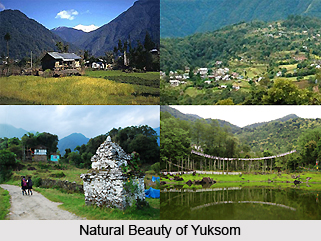 Yuksom is a historical town in Geyzing subdivision of West Sikkim district. It was the first capital of Sikkim that was established in 1642 AD by Phuntsog Namgyal. He was the first Chogyal of Sikkim. The dynastic rule of the Chogyals lasted for 333 years. Many monasteries are also located here. The Chogyal established the first monastery at Yuksom in Sikkim known as the Dubdi Monastery. This monastery was established in 1701. Yuksom is thus considered a model village for eco-tourism. For the Bhutia tribal community of Sikkim, Yuksom has special religious and cultural significance.
Yuksom is a historical town in Geyzing subdivision of West Sikkim district. It was the first capital of Sikkim that was established in 1642 AD by Phuntsog Namgyal. He was the first Chogyal of Sikkim. The dynastic rule of the Chogyals lasted for 333 years. Many monasteries are also located here. The Chogyal established the first monastery at Yuksom in Sikkim known as the Dubdi Monastery. This monastery was established in 1701. Yuksom is thus considered a model village for eco-tourism. For the Bhutia tribal community of Sikkim, Yuksom has special religious and cultural significance.
Etymology of Yuksom
Yuksom literally means the "meeting place of the three learned monks" as three monks who came from Tibet selected Phuntsog Namgyal as the first King of Sikkim and gave him the title Chogyal. `Chogyal` means "Religious King" or "the king who rules with righteousness". Yuksom is also one of the sacred landscape "Demazong" (meaning a valley of rice) of four religious sites blessed by Guru Padmasambhava, which are considered to be the four plexuses of the human body, and Yuksom symbolically represents the `third eye`.
History of Yuksom
History of introduction of Buddhism to the state from Tibet is as early as in the 9th century. In the struggle for power between the "Yellow hats" and the "Red hats" in Tibet, the latter had migrated to Sikkim and converted the mild mannered Lepchas (the aboriginal inhabitants) to Buddhism. In the 13th century, relations between Sikkim and Tibet were cemented by a "Brother Hood treaty" signed between the Lepcha chief Thekong-thek and Tibetan prince Khe-Bhumsa at Kavi, in north Sikkim.
In 1641, Lama Lutsum Chembo travelled from Tibet to Denjong now known as Sikkim to propagate the Buddhist religion. He was then joined by two other lamas, Sempa Chembo and Rinzing Chembo. The trinity of the most revered Lamas belonged to the Kham district in Tibet. Their primary aim was to perpetuate Tibetan hold on Sikkim and with a mission to propagate Buddhism in Sikkim. They assembled from different directions at Norbugang, later came to be known as Yuksom. The area in Rathong chu valley at Narbugong was considered as blessed by Guru Padma Sambhava. Since the vision of Saint Padmasambhava had predicted the essentiality of a fourth person for the purpose, the Lamas went in pursuit of the fourth person, as the three lamas represented three directions of North, South and West in Tibet. In 1642, the three lamas went in search of the chosen person in the eastern region. Near the present day Gangtok, they found a man churning milk. He offered them some refreshments and gave them shelter. So impressed were they by his deeds that they realised that he was a chosen one. They also identified Phunstsog Namgyal`s ancestral royal links with Tibet and decided that he was the right person to become the temporal and religious head of the region, and then they brought him to Yuksom. They then crowned him at Norbugang near Yuksom as the temporal and religious king of Sikkim, with the title of "Chogyal". The crowning took place at Norbugang on a pedestal set in stones, in a pine-covered hill, and he was anointed by sprinkling water from a sacred urn. At that time he was 38 years of age. He was a fifth generation descendant of Guru Tashi, a 13th century prince from the Mi-nyak House in Kham in Eastern Tibet.
Thereafter, the dynastic rule of Chogyals, propagation of the Buddhist religion and building of monasteries and chortens took firm roots in Sikkim. The Namgyal monarchy of 12 kings lasted from 1642 till 1975 (333 years). Tibetan Mahayana Buddhism known as Vajrayana sect was introduced, which ultimately was recognized as the state religion of Sikkim.
Geography of Yuksom
Yuksom is a large village with a total area of 812.16 hectares. It is located in a basin-like valley surrounded by mountain ranges. It is located at the head of the Kanchenjunga National Park. The popular mountaineering trek starts from Yuksom. The climate in Yuksom is pleasant during the months of March to June and September to November. December and February are the coldest months.
Culture of Yuksom
A biodiversity festival was held at Yuksom. It is the first of its kind to be held in Sikkim by KCC, and the Forest Department of Government of Sikkim. The festival was held to spread the awareness among the people of the villages to conserve cultural and natural heritage. In the festival the focus was on pictorial exhibitions of the natural biodiversity setting and cultural heritage of the Rathong Chuu valley. It also taught the ways of preserving the biosphere, interest of ecotourism in the valley along the trek route Yuksom Dzongri through the Kanchenjunga National Park.



















